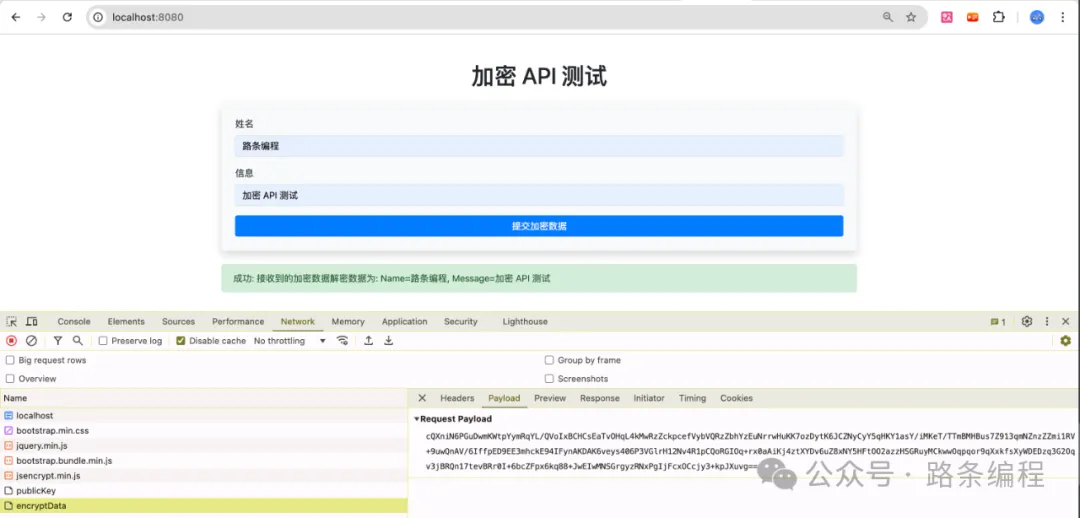速覽!Spring Boot 3.3 快速實(shí)現(xiàn) API 加密的最佳實(shí)踐
景(如支付、登錄認(rèn)證等),API 的數(shù)據(jù)傳輸面臨著信息泄露的風(fēng)險(xiǎn)。因此,在這些場景下,數(shù)據(jù)加密顯得尤為重要。為了提高安全性,RSA 加密算法作為非對稱加密的一種典型實(shí)現(xiàn),廣泛應(yīng)用于 API 加密場景中。本文將深入介紹 RSA 加密的基本原理,并結(jié)合 SpringBoot3.3,使用 rsa-encrypt-body-spring-boot 快速實(shí)現(xiàn) API 數(shù)據(jù)加解密。
RSA 加密算法簡介
RSA 加密是一種非對稱加密算法,具有公鑰和私鑰的密鑰對。公鑰用于加密數(shù)據(jù),而私鑰用于解密。加密和解密的具體流程如下:
- 生成密鑰對:RSA 通過數(shù)學(xué)算法生成一對密鑰:公鑰(Public Key)和私鑰(Private Key)。
- 加密數(shù)據(jù):前端(或客戶端)使用服務(wù)器提供的公鑰將敏感數(shù)據(jù)進(jìn)行加密。由于加密過程不可逆,只有擁有私鑰的服務(wù)器才能解密這些數(shù)據(jù)。
- 傳輸加密數(shù)據(jù):客戶端將加密后的數(shù)據(jù)通過 API 發(fā)送至后端服務(wù)器。
- 解密數(shù)據(jù):
服務(wù)器端收到加密數(shù)據(jù)后,使用 RSA 私鑰解密得到原始數(shù)據(jù)。
解密后的數(shù)據(jù)再由服務(wù)器進(jìn)行進(jìn)一步的業(yè)務(wù)處理。
RSA 的優(yōu)勢在于公鑰可以公開分發(fā),不需要像對稱加密算法一樣保證密鑰的安全性。同時(shí),只有服務(wù)器端持有私鑰,能夠有效避免數(shù)據(jù)在傳輸過程中被竊取和篡改。
運(yùn)行效果:
 圖片
圖片
若想獲取項(xiàng)目完整代碼以及其他文章的項(xiàng)目源碼,且在代碼編寫時(shí)遇到問題需要咨詢交流,歡迎加入下方的知識(shí)星球。
接下來,我們將結(jié)合 SpringBoot 實(shí)現(xiàn)基于 RSA 加密的 API 數(shù)據(jù)加密傳輸。
項(xiàng)目依賴配置
在項(xiàng)目中首先需要配置 pom.xml 文件以引入相關(guān)依賴:
pom.xml 配置*
<?xml versinotallow="1.0" encoding="UTF-8"?>
<project xmlns="http://maven.apache.org/POM/4.0.0" xmlns:xsi="http://www.w3.org/2001/XMLSchema-instance"
xsi:schemaLocation="http://maven.apache.org/POM/4.0.0 https://maven.apache.org/xsd/maven-4.0.0.xsd">
<modelVersion>4.0.0</modelVersion>
<parent>
<groupId>org.springframework.boot</groupId>
<artifactId>spring-boot-starter-parent</artifactId>
<version>3.3.4</version>
<relativePath/> <!-- lookup parent from repository -->
</parent>
<groupId>com.icoderoad</groupId>
<artifactId>rsa-encrypt</artifactId>
<version>0.0.1-SNAPSHOT</version>
<name>rsa-encrypt</name>
<description>Demo project for Spring Boot</description>
<properties>
<java.version>17</java.version>
</properties>
<dependencies>
<!-- RSA 加密依賴 -->
<dependency>
<groupId>cn.shuibo</groupId>
<artifactId>rsa-encrypt-body-spring-boot</artifactId>
<version>1.0.1.RELEASE</version>
</dependency>
<!-- Lombok 依賴 -->
<dependency>
<groupId>org.projectlombok</groupId>
<artifactId>lombok</artifactId>
<scope>provided</scope>
</dependency>
<!-- Thymeleaf 依賴 -->
<dependency>
<groupId>org.springframework.boot</groupId>
<artifactId>spring-boot-starter-thymeleaf</artifactId>
</dependency>
<!-- Web 依賴 -->
<dependency>
<groupId>org.springframework.boot</groupId>
<artifactId>spring-boot-starter-web</artifactId>
</dependency>
<dependency>
<groupId>org.springframework.boot</groupId>
<artifactId>spring-boot-starter-test</artifactId>
<scope>test</scope>
</dependency>
</dependencies>
<build>
<plugins>
<plugin>
<groupId>org.springframework.boot</groupId>
<artifactId>spring-boot-maven-plugin</artifactId>
</plugin>
</plugins>
</build>
</project>application.yml 配置
在 application.yml 中配置 RSA 加密的公鑰和私鑰,保證后端可以正常解密前端的加密數(shù)據(jù)。
rsa:
encrypt:
open: true # 是否開啟加密 true or false
showLog: true # 是否打印加解密log true or false
timestampCheck: true # 是否開啟時(shí)間戳檢查 true or false
publicKey: |-
MIIBIjANBgkqhkiG9w0BAQEFAAOCAQ8AMIIBCgKCAQEArw2n5D...
privateKey: |-
MIIEvAIBADANBgkqhkiG9w0BAQEFAASCBKcw...** 使用 OpenSSL 生成 RSA 密鑰對**
- 生成 RSA 私鑰(private key): 運(yùn)行以下命令生成一個(gè) 2048 位的私鑰:
openssl genpkey -algorithm RSA -out private_key.pem -pkeyopt rsa_keygen_bits:2048這會(huì)生成一個(gè) private_key.pem 文件,文件中包含 -----BEGIN PRIVATE KEY----- 和 -----END PRIVATE KEY-----。
從私鑰生成公鑰(public key): 使用以下命令生成公鑰:
openssl rsa -pubout -in private_key.pem -out public_key.pem這會(huì)生成一個(gè) public_key.pem 文件,包含公鑰內(nèi)容。
移除頭尾標(biāo)識(shí)符,獲得純 Base64 內(nèi)容: 打開 private_key.pem 和 public_key.pem 文件,手動(dòng)移除頭尾標(biāo)識(shí)符(如 -----BEGIN PRIVATE KEY----- 和 -----END PRIVATE KEY-----),并將中間的內(nèi)容保存下來。這個(gè)內(nèi)容是純粹的 Base64 編碼后的密鑰。私鑰的格式看起來會(huì)像這樣(去掉換行符后):
MIIEvQIBADANBgkqhkiG9w0BAQEFAASCBKcwggSjAgEAAoIBAQC1...替換 application.yml 中的密鑰: 將得到的純 Base64 內(nèi)容替換到你的 application.yml 文件中:
rsa:
encrypt:
publicKey: |
MIIBIjANBgkqhkiG9w0BAQEFAAOCAQ8AMIIBCgKCAQEArw2n5D...
privateKey: |
MIIEvAIBADANBgkqhkiG9w0BAQEFAASCBKcw...啟動(dòng)類
注意:啟動(dòng)類 RsaEncryptApplication 中添加@EnableSecurity注解
package com.icoderoad.rsa.encrypt;
import org.springframework.boot.SpringApplication;
import org.springframework.boot.autoconfigure.SpringBootApplication;
import cn.shuibo.annotation.EnableSecurity;
@EnableSecurity
@SpringBootApplication
public class RsaEncryptApplication {
public static void main(String[] args) {
SpringApplication.run(RsaEncryptApplication.class, args);
}
}配置讀取類
通過 @ConfigurationProperties 來讀取加密相關(guān)的配置信息。我們使用 Lombok 的注解來簡化代碼,實(shí)現(xiàn) Getter 和 Setter。
package com.icoderoad.rsa.encrypt.config;
import org.springframework.boot.context.properties.ConfigurationProperties;
import org.springframework.stereotype.Component;
import lombok.Data;
@Data
@Component
@ConfigurationProperties(prefix = "encrypt.rsa")
public class RsaProperties {
private String publicKey;
private String privateKey;
}后端代碼實(shí)現(xiàn)
實(shí)體類
package com.icoderoad.rsa.encrypt.entity;
import lombok.Data;
@Data
public class User {
private String name;
private String message;
}Controller 需要接收前端發(fā)送的加密 JSON 數(shù)據(jù),并通過 RSA 進(jìn)行解密處理。這里修改了前端傳輸?shù)臄?shù)據(jù)格式,并使用 @RequestBody 解析 JSON 格式的數(shù)據(jù)。
package com.icoderoad.rsa.encrypt.controller;
import org.springframework.beans.factory.annotation.Autowired;
import org.springframework.web.bind.annotation.GetMapping;
import org.springframework.web.bind.annotation.PostMapping;
import org.springframework.web.bind.annotation.RequestBody;
import org.springframework.web.bind.annotation.RequestMapping;
import org.springframework.web.bind.annotation.RestController;
import com.icoderoad.rsa.encrypt.config.RsaProperties;
import com.icoderoad.rsa.encrypt.entity.User;
import cn.shuibo.annotation.Decrypt;
@RestController
@RequestMapping("/api/demo")
public class DemoController {
@Autowired
private RsaProperties rsaProperties;
@GetMapping("/publicKey")
public String getPublicKey() {
// 返回配置中的公鑰
return rsaProperties.getPublicKey();
}
@Decrypt
@PostMapping("/encryptData")
public String receiveEncryptedData(@RequestBody User user) {
// 獲取解密后的數(shù)據(jù)
String name = user.getName();
String message = user.getMessage();
return "接收到的加密數(shù)據(jù)解密數(shù)據(jù)為: Name=" + name + ", Message=" + message;
}
}前端代碼實(shí)現(xiàn)
我們通過 Thymeleaf 模板引擎構(gòu)建頁面,并使用 jQuery 和 Bootstrap 來處理前端加密邏輯。
在 src/main/resources/templates 目錄下創(chuàng)建 index.html 文件:
<!DOCTYPE html>
<html lang="zh" xmlns:th="http://www.thymeleaf.org">
<head>
<meta charset="UTF-8">
<meta name="viewport" content="width=device-width, initial-scale=1.0">
<title>API 加密測試</title>
<!-- 引入 Bootstrap 和 jQuery 的 CDN -->
<link rel="stylesheet">
<script src="https://cdn.bootcss.com/jquery/3.5.1/jquery.min.js"></script>
<script src="https://cdn.bootcss.com/bootstrap/4.5.0/js/bootstrap.bundle.min.js"></script>
</head>
<body>
<div class="container mt-5">
<h1 class="text-center mb-4">加密 API 測試</h1>
<form id="encryptForm" class="shadow p-4 rounded bg-light">
<div class="form-group">
<label for="name">姓名</label>
<input type="text" class="form-control" id="name" placeholder="輸入姓名" required>
</div>
<div class="form-group">
<label for="message">信息</label>
<input type="text" class="form-control" id="message" placeholder="輸入信息" required>
</div>
<button type="button" class="btn btn-primary btn-block">提交加密數(shù)據(jù)</button>
</form>
<div id="result" class="mt-4"></div>
</div>
<script src="https://cdnjs.cloudflare.com/ajax/libs/jsencrypt/3.0.0/jsencrypt.min.js"></script>
<script>
$(document).ready(function() {
// 獲取公鑰
$.get("/api/demo/publicKey", function(publicKey) {
const encrypt = new JSEncrypt();
encrypt.setPublicKey('-----BEGIN PUBLIC KEY-----' + publicKey + '-----END PUBLIC KEY-----');
$("#encryptForm button").click(function(event) {
event.preventDefault(); // 防止按鈕默認(rèn)提交
// 獲取用戶輸入
const name = $("#name").val();
const message = $("#message").val();
var user = {"name": name, "message": message};
// 加密數(shù)據(jù)
const encryptedData = encrypt.encrypt(JSON.stringify(user));
// 使用 AJAX 提交加密數(shù)據(jù)
$.ajax({
url: "/api/demo/encryptData", // API 端點(diǎn)
method: "POST",
contentType: "application/json",
data: encryptedData,
success: function(response) {
console.log("成功:", response);
$("#result").html(`<div class="alert alert-success">成功: ${response}</div>`); // 顯示返回的解密結(jié)果
},
error: function(error) {
console.error("錯(cuò)誤:", error);
$("#result").html(`<div class="alert alert-danger">提交失敗,請重試!</div>`);
}
});
});
});
});
</script>
</body>
</html>前端加密邏輯說明
在上述代碼中,前端通過 btoa 模擬了數(shù)據(jù)加密,實(shí)際生產(chǎn)環(huán)境中應(yīng)使用成熟的前端 RSA 加密庫,例如 jsencrypt 來完成 RSA 加密操作。頁面通過 jQuery 提交加密后的數(shù)據(jù)至后端。
運(yùn)行項(xiàng)目
- 啟動(dòng) SpringBoot 項(xiàng)目后,訪問 http://localhost:8080。
- 輸入姓名和信息,點(diǎn)擊“提交加密數(shù)據(jù)”,頁面將通過 jQuery 發(fā)起 POST 請求,并傳輸加密后的數(shù)據(jù)。
- 后端接收到加密數(shù)據(jù)后,通過 RSA 解密工具解密,并返回解密結(jié)果。
結(jié)語
通過本文,我們了解了 RSA 加密的基本原理,并結(jié)合 SpringBoot3.3 快速實(shí)現(xiàn)了 API 數(shù)據(jù)的加解密。在實(shí)際生產(chǎn)環(huán)境中,RSA 加密能夠有效保護(hù)敏感信息的安全傳輸。然而,RSA 也存在一些限制,如加密數(shù)據(jù)長度受限、性能開銷較大等問題。因此,對于大規(guī)模數(shù)據(jù)傳輸,可以結(jié)合對稱加密和非對稱加密(如 RSA + AES)來提高系統(tǒng)的安全性和效率。
對于 API 安全性的提升,除了加密傳輸,其他安全措施(如接口簽名、白名單 IP 過濾等)也應(yīng)配合使用,全面提高系統(tǒng)的防護(hù)能力。








































